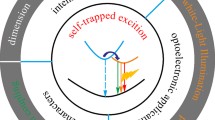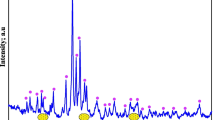Abstract.
Holographic gratings are recorded and thermally fixed in iron-doped photorefractive lithium-niobate crystals. A spatially modulated concentration of filled and empty electron traps (Fe2+ and Fe3+) yields a modulated dark conductivity. As a consequence, dark diffusion currents and dark drift currents arise. Space–charge fields and electro-optic refractive-index changes build up. An additional refractive-index grating, which may originate from a modulated proton concentration, as well as a pronounced absorption grating arising from the modulated Fe2+ concentration are also observed. The dark development has practical advantages: thermally fixed holograms can be used in devices without the need to develop them freshly from time to time by illumination. Although with dark development diffraction efficiencies up to 50% are demonstrated, in general the efficiencies are smaller compared to those achieved by development with light.
Similar content being viewed by others
Author information
Authors and Affiliations
Additional information
Received: 28 June 2000 / Published online: 8 November 2000
Rights and permissions
About this article
Cite this article
Nee, I., Müller, M. & Buse, K. Development of thermally fixed photorefractive holograms without light . Appl Phys B 72, 195–200 (2001). https://doi.org/10.1007/s003400000444
Issue Date:
DOI: https://doi.org/10.1007/s003400000444




